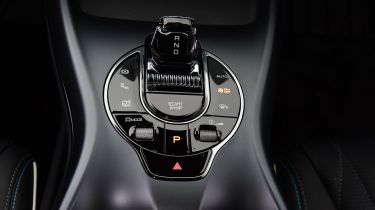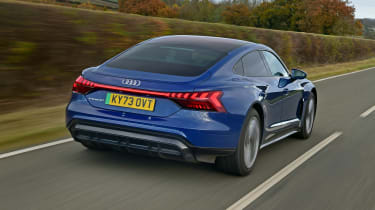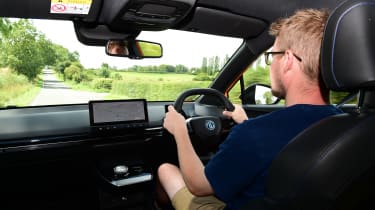Do electric cars have gearboxes?
Do electric cars have gears? We cover the differences between the transmissions fitted to electric cars and combustion engine cars

As car manufacturers begin to offer a wider range of electric cars, more buyers are shifting from models with traditional combustion engines to those powered by batteries. If you’re looking to make the switch but you’ve never driven a fully electric car before, you’ll undoubtedly have several questions about EVs, such as: do electric cars have gearboxes?
Generally, no. Electric cars do not have a conventional gearbox that you would find in a petrol or diesel-powered car. From behind the wheel, driving an electric car will feel similar to a modern automatic petrol or diesel car. However, they usually only have one gear, as opposed to the six, seven or more in a traditional automatic.
Why don’t electric cars have gearboxes?
It comes down to how electric motors produce their power and torque. Torque, if you’re not familiar, is essentially the motor or engine’s ‘twisting’ force that’s used to get the car moving. The higher the torque, the easier it is for the car to accelerate. Petrol and diesel cars need to build up engine revs in order to reach peak torque, and gears are used to ensure that the engine remains within this ideal rev range.
 Top 10 best electric SUVs – the ones to buy in 2025
Top 10 best electric SUVs – the ones to buy in 2025
The electric motors used in EVs produce their peak torque nearly instantaneously. This means that they can use just one gear and still accelerate from a standstill without bogging down. With no need to change gears at all, an electric car will continue to seamlessly accelerate until it reaches its top speed. There isn’t even a reverse ‘gear’ per say, as electric motors can run in both forward and backwards directions.
Electric cars have a switch that operates much like the one you’d find in an automatic which allows you to choose between D (Drive), R (Reverse), N (Neutral), P (Park). In some models, you may also be able to choose between different drive modes which alter power delivery depending on whether you want a sportier or more economical drive, usually denoted by an S (Sport) or E (Eco).

It’s worth noting that a handful of high-performance EVs, including the Porsche Taycan, Audi e-tron GT and Lotus Eletre R, use a two-speed automatic gearbox, but this is simply to improve acceleration performance. You won’t find this in most EVs as most manufacturers prefer the smoothness and simplicity of a single gear. In fact, Porsche has ditched the system for the new electric Porsche Macan.
As it stands, there are no electric cars on the market with a gearbox as they’re not necessary, however, some automakers are creating simulated gearboxes to mimic the feeling of a conventional combustion-engined car. Hyundai’s latest Ioniq 5 N electric hot hatch uses a system that mimics a sequential gearbox by adjusting the motors’ power delivery as you cycle through the ‘gears’ and sends vibrations through the steering wheel and pedals to complete the illusion.
How does it feel to drive an electric car?
Once you’ve driven off, you may be surprised to find that, as the car accelerates and slows down, it doesn’t have the feeling of shifting through gears; it’s just a smooth, linear drive right up to cruising speeds and back to a standstill instead.
This is especially impressive considering how quickly some electric vehicles can accelerate. Even the MG4 XPower family hatchback can cover 0-62mph in under four seconds, a time that would trouble many expensive petrol-powered sports cars.

This is possible because electric motors are more flexible than conventional, fuel-burning, engines. An EV motor can produce its pulling power instantaneously as soon as you press the accelerator.
The electric motors are also power efficient throughout this rev range, meaning they don’t have to be sitting in a small, narrow rev band like a conventional engine to deliver optimal performance.
The different gear ratios help the conventional engine keep within this narrow power band at different road speeds. That’s why a petrol car will easily accelerate to 20mph in first gear, but won’t go much faster without reaching the engine’s rev limiter, or red line. With the same logic, drivers will struggle to pull away from a standstill in sixth gear, as this ratio is designed for faster driving.
 Fast charging or rapid charging? Your guide to electric car charger types
Fast charging or rapid charging? Your guide to electric car charger types
This all means an electric vehicle can reach its top speed in a single gear, which is chosen by the engineers to offer the best compromise between low and high-speed performance. Most are capable of accelerating at town speeds faster than a hot-hatchback and easily breaking the motorway speed limit, so there’s no great sacrifice involved.
Is an electric car easier to maintain?
This setup makes EVs much less complicated to build and maintain. Installing a driveline system with multiple gears would immediately add cost, inflating the car’s price. With EVs already seeming comparatively expensive, manufacturers obviously want to avoid this.
However, this single-gear rule may change for EVs in the future. In Formula E, the electric single-seater race series, some teams opt to run their vehicles with a three-speed gearbox to give the best combination of performance and efficiency as power outputs are limited by the rules.
For road cars, several concepts have been shown that suggest that cheap-to-make two-speed gearboxes may be used in some future electric models, as it will allow for smaller, less powerful and cheaper electric motors to be fitted and range to be increased without harming performance.
Do hybrid cars have gearboxes?
That covers pure EVs but what about full hybrids and plug-in hybrids (PHEVs), which have both an electric motor and a petrol or diesel engine? Most modern hybrids also have some form of automatic gearbox, which means you don’t have to get used to anything complicated in order to drive one. But under the skin, the systems used can be quite different.
The main reason for the prevalence of automatic gearboxes in hybrids is their use of multiple motors, which juggle power and may cut in and out, making it easier for an automatic gearbox to smooth out these changes according to computer software. This precise control can also be essential for ensuring a hybrid hits precise fuel efficiency and emissions targets as you drive along.
As EVs and hybrids become increasingly popular, advanced and more affordable, and especially as we approach the 2035 ban on the sale of new petrol and diesel cars, expect more options and technical advances to make them more efficient. These aren’t likely to make life for the driver any more complicated.
Want to learn more about electric cars? Why not read our list of the best electric cars currently on sale…
Recommended

New Subaru Trailseeker revealed as rugged electric SUV with 375bhp

New Subaru Solterra brings more range, power and polish
Most Popular
Tips & advice

Car dashboard warning lights: what does each symbol mean?

Electric car charging stations: public networks, charger types, apps and maps








